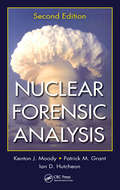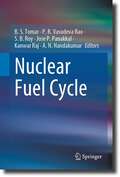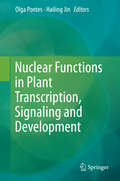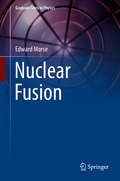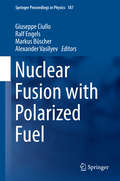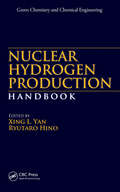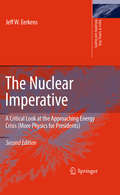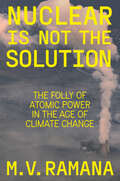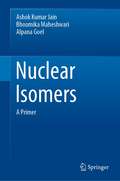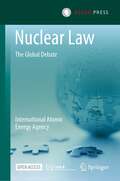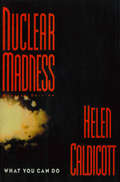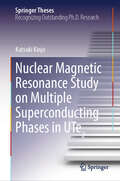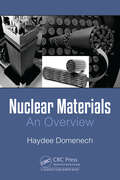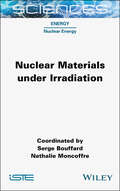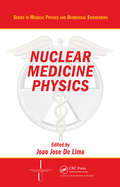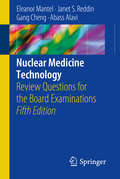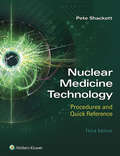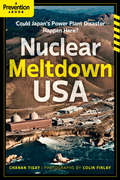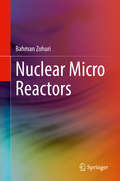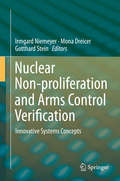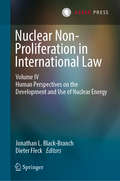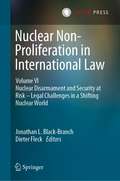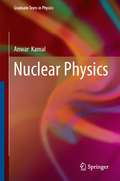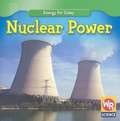- Table View
- List View
Nuclear Forensic Analysis
by Kenton J. Moody Patrick M. Grant Ian D. HutcheonNow in its second edition, Nuclear Forensic Analysis provides a multidisciplinary reference for forensic scientists, analytical and nuclear chemists, and nuclear physicists in one convenient source. The authors focus particularly on the chemical, physical, and nuclear aspects associated with the production or interrogation of a radioactive sample.
Nuclear Fuel Cycle
by B. S. Tomar P. R. Vasudeva Rao S. B. Roy Jose P. Panakkal Kanwar Raj A. N. NandakumarThe present book describes the various processes involved in different stages of the entire nuclear fuel cycle, which include exploration of uranium, thorium, and other nuclear materials, mining and milling of ores, conversion of the separated nuclear material into nuclear grade, fabrication of different types of nuclear fuels and their physical as well as chemical quality control, thermodynamics of the interaction among fuel and fission products during reactor operation, post irradiation examination, spent fuel reprocessing, radioactive waste management, accounting and control of nuclear materials, and safety aspects involved in handling and transportation of nuclear materials. The book provides the fundamental knowledge to the practicing nuclear scientists and engineers, young researchers, and postgraduate students interested in pursuing a career in nuclear industry in general and those engaged in human resource development in the field of nuclear science and technology in particular. It can also be prescribed as a textbook for a course on nuclear fuel cycle at postgraduate level.
Nuclear Functions in Plant Transcription, Signaling and Development
by Olga Pontes Hailing JinThe genome is more than a linear code as depicted by its DNA sequences as several interacting factors play a crucial role in shaping its organization and function. The complete sequences of a number of plant genomes and the recent advances of high-throughput technologies has fueled research efforts in the field of Plant Nuclear Biology unveiling numerous insights about the mechanisms underlying genome regulation. Genomic information is being integrated into molecular- and cellular-level mechanisms of the plant processes. A host of nuclear processes underlie key developmental processes as well as biotic and abiotic interactions. Non-coding RNAs have been increasingly recognized as players in gene expression and genome defense and integrity. However, in vivo, genomes exist as elaborate physical structures, and their functional properties are strongly determined by their cellular organization. Various types of subcellular structure have been identified in the nucleus, which are associated with transcription factors, RNA processing proteins and epigenetic regulators. Interestingly, these nuclear bodies display different behaviors in response to the environment. This book compiles a series of landmark discussions of the recent advances in plant nuclear biology research focusing in the functional relevance of the arrangement of genomes and nuclear processes that impact plant physiology and development.
Nuclear Fusion (Graduate Texts in Physics)
by Edward MorseThe pursuit of nuclear fusion as an energy source requires a broad knowledge of several disciplines. These include plasma physics, atomic physics, electromagnetics, materials science, computational modeling, superconducting magnet technology, accelerators, lasers, and health physics. Nuclear Fusion distills and combines these disparate subjects to create a concise and coherent foundation to both fusion science and technology. It examines all aspects of physics and technology underlying the major magnetic and inertial confinement approaches to developing nuclear fusion energy. It further chronicles latest developments in the field, and reflects the multi-faceted nature of fusion research, preparing advanced undergraduate and graduate students in physics and engineering to launch into successful and diverse fusion-related research.Nuclear Fusion reflects Dr. Morse’s research in both magnetic and inertial confinement fusion, working with the world’s top laboratories, and embodies his extensive thirty-five year career in teaching three courses in fusion plasma physics and fusion technology at University of California, Berkeley.
Nuclear Fusion with Polarized Fuel
by Giuseppe Ciullo Ralf Engels Markus Büscher Alexander VasilyevThis book offers a detailed examination of the latest work on the potential of polarized fuel to realize the vision of energy production by nuclear fusion. It brings together contributions from nuclear physicists and fusion physicists with the aims of fostering exchange of information between the two communities, describing the current status in the field, and examining new ideas and projects under development. It is evident that polarized fuel can offer huge improvements for the first generation of fusion reactors and open new technological possibilities for future generations, including neutron lean reactors, which could be the most popular and sustainable energy production option to avoid environmental problems. Nevertheless, many questions must be resolved before polarized fuel can be used for energy production in the different reactor types. Readers will find this book to be a stimulating source of information on the key issues. It is based on contributions from leading scientists delivered at the meetings "Nuclear Fusion with Polarized Nucleons" (Trento, November 2013) and "PolFusion" (Ferrara, July 2015).
Nuclear Hydrogen Production Handbook (Green Chemistry and Chemical Engineering)
by Xing L. Yan Ryutaro HinoWritten by two leading researchers from the world-renowned Japan Atomic Energy Agency, the Nuclear Hydrogen Production Handbook is an unrivalled overview of current and future prospects for the effective production of hydrogen via nuclear energy. Combining information from scholarly analyses, industrial data, references, and other resources, this h
The Nuclear Imperative: A Critical Look at the Approaching Energy Crisis (More Physics for Presidents)
by Jeff EerkensIn this global wake-up call, nuclear physicist Jeff Eerkens explores remedies for the impending energy crisis, when oil and natural gas are depleted. The Nuclear Imperative demonstrates that solar, wind, and biomass power are incapable of supplying the enormous quantities of electricity and heat needed for manufacturing portable synthetic fuels to replace our current use of fossil fuels. It offers a fresh look at uranium-produced energy as the optimal affordable solution.
Nuclear is Not the Solution: The Folly of Atomic Power in the Age of Climate Change
by M.V. RamanaNUCLEAR POWER WILL SLOW OUR RESPONSE TO CLIMATE CHANGE AND INCREASE THE RISK OF WEAPONS PROLIFERATION AND CATASTROPHETHE CLIMATE CRISIS has propelled nuclear energy back into fashion. Its proponents argue we already have the technology of the future and that it only needs perfection and deployment. Nuclear Is Not the Solution demonstrates why this sort of thinking is not only naïve but dangerous.Even beyond the horrific implications of meltdown and the intractable problem of waste disposal, nuclear is not practicable on such a large scale. Any appraisal of future energy technology depends on two important parameters: cost and time. Nuclear fails on both counts. It is more costly than its renewable competitors wind and solar. And, importantly given the need for rapid transformation, it is slow. A plant takes a decade to come online. If you include permits and fundraising, this adds another decade. And we should not forget the deep roots it has in the defense industry.M. V. Ramana&’s powerful book destroys any illusion that nuclear is our answer to climage change, untangling technical arguments into simple and sensible language. Importantly, Nuclear Is Not the Solution also unmasks the powerful groups with vested interests in the maintenance of the status quo, currently working hard to greenwash a spectacularly dirty industry.
Nuclear Isomers: A Primer
by Ashok Kumar Jain Bhoomika Maheshwari Alpana GoelNuclear isomers are the long-lived excited states of nuclei. Therefore, they constitute the meta-stable landscape of nuclei. The first isomer was probably identified as early as 1921. Since then, the number of isomers has been growing steadily picking up pace in recent times.Interest in nuclear isomers has grown in recent years for many reasons. The experimental capabilities to observe isomers have been expanding to cover a wider time scale. This has opened up new windows to observe and decipher the underlying nuclear structure and interactions. Further, the isomers are beginning to be seen as potential energy storage devices and nuclear clocks with a host of applications. Possible discovery of a gamma ray laser has also ignited many researches in this area.Isomers now cover the full nuclear landscape with structural peculiarities specific to each region of the nuclear chart. Exploring the nuclear isomers, therefore, provides a novel insight into the nuclear structure properties of that region. There could be many different reasons for the long lives of excited nuclear states, which lead to the classification of isomers.Isomers are broadly classified in to four classes: Spin isomers, shape isomers, fission isomers and K-isomers. Seniority isomers have also been identified which are often clubbed with the spin isomers. We discuss this classification and the underlying causes in detail. Many examples are considered to highlight the large variety of isomers. The range of half-lives covered by the isomers varies from billions of years to nano-seconds and even small. To understand this vast variation is a fascinating endeavor in itself. The angular momentum couplings, nuclear shapes, pairing etc. conspire together to give this vast range of half-lives. We go through these aspects in detail, highlighting the various selection rules at work.It is interesting that the nuclear shapes play an important role in many types of isomers. The spin isomers, which occur in spherical or, near-spherical nuclei, are generally confined to the magic numbers. Seniority isomers are largely found in semi-magic nuclei and should be explored in conjunction with the spin isomers. New developments in seniority and generalized seniority isomers are discussed in detail. As the nuclei deform; the nature of isomers changes. We take a close look into the decay properties of isomers in deformed nuclei, particularly the K isomers, the shape isomers and the fission isomers. While doing so, the theoretical and experimental developments of isomers are also addressed. A number of open questions are posed for possible new experiments and better understanding of the isomers.
Nuclear Law: The Global Debate
by International Atomic Energy AgencyThis open access book traces the journey of nuclear law: its origins, how it has developed, where it is now, and where it is headed. As a discipline, this highly specialized body of law makes it possible for us to benefit from the life-saving applications of nuclear science and technology, including diagnosing cancer as well as avoiding and mitigating the effects of climate change. This book seeks to give readers a glimpse into the future of nuclear law, science and technology. It intends to provoke thought and discussion about how we can maximize the benefits and minimize the risks inherent in nuclear science and technology. This compilation of essays presents a global view in discipline as well as in geography. The book is aimed at representatives of governments—including regulators, policymakers and lawmakers—as well representatives of international organizations and the legal and insurance sectors. It will be of interest to all those keen to better understand the role of law in enabling the safe, secure, and peaceful use of nuclear technology around the world. The contributions in this book are written by leading experts, including the IAEA’s Director General, and discuss the four branches of nuclear law—safety, security, safeguards and nuclear liability—and the interaction of nuclear law with other fields of national and international law.
Nuclear Madness: What You Can Do
by Helen Caldicott"As a physician, I contend that nuclear technology threatens life on our planet with extinction. If present trends continue, the air we breathe, the food we eat, and the water we drink will soon be contaminated with enough radioactive pollutants to pose a potential health hazard far greater than any plague humanity has ever experienced."--Helen Caldicott First published in 1978, Helen Caldicott's cri du coeur about the dangers of nuclear power became an instant classic. In the intervening sixteen years much has changed--the Cold War is over, nuclear arms production has decreased, and there has been a marked growth in environmental awareness. But the nuclear genie has not been forced back into the bottle. The disaster at Chernobyl and the "incidents" at other plants around the world have disproven the image of "safe" nuclear power. Nuclear waste dumping has further poisoned our environment, and developing nuclear technology in the Third World poses still further risks. In this completely revised, updated, and expanded edition, Dr. Caldicott defines for the 1990s the dangers of this madness--including the insidious influence of the nuclear power industry and the American government's complicity in medical "experiments" using nuclear material--and calls on us to accept the moral challenge to fight against it, both for our own sake and for that of future generations.
Nuclear Magnetic Resonance Studies of Interfacial Phenomena (Surfactant Science)
by Vladimir M. Gun'ko Vladimir V. TurovProperties and applications of high surface area materials depend on interfacial phenomena, including diffusion, sorption, dissolution, solvation, surface reactions, catalysis, and phase transitions. Among the physicochemical methods that give useful information regarding these complex phenomena, nuclear magnetic resonance (NMR) spectroscopy is the
Nuclear Magnetic Resonance Study on Multiple Superconducting Phases in UTe2 (Springer Theses)
by Katsuki KinjoThis book provides an insight into spin-triplet superconductivity, which rapidly becomes better understood in recent years, from the perspective of a microscopic measurement technique called nuclear magnetic resonance (NMR). The compound UTe2, the target material of this book, was confirmed to show superconductivity in 2018, and its peculiarity is very similar to that of other uranium-based ferromagnetic superconductors, ensuring spin triplet superconductivity. This book begins with the fundamentals of superconductivity and subsequently overviews research in spin-triplet superconductivity. The similarity between the high-field superconducting phase in UTe2 and the superconducting phase under pressure is particularly interesting among the various superconducting phenomena observed so far. This book provides a concise introduction to superconductivity, so that the book is also intended for wide readership including the beginners interested in the phenomenon of superconductivity and undergraduate and graduate students. It also cover the NMR measurement from the basic derivation, which is accessible for beginners. The target material UTe2 is skillfully described, including a selection of related works to this book.
Nuclear Materials: An Overview
by Haydee DomenechThis book reviews the critical scope of nuclear materials, which play an essential role in decreasing greenhouse gas emissions. It traces historical landmarks from the years preceding World War II to the atomic bomb era. Key topics covered include the concept of nuclear materials and their connection to the Non-Proliferation Treaty (NPT), the steps of the nuclear fuel cycle, and advanced reactor technologies. Additionally, the book addresses safety and security considerations, including radioactive waste and spent fuel management. Through this comprehensive exploration, readers can gain insights into the intricate world of nuclear materials, their impact on global security, and the path toward sustainable energy solutions.
Nuclear Materials under Irradiation
by Serge Bouffard Nathalie MoncoffreAt every stage of the fuel cycle, the materials used are at the heart of nuclear energy safety issues. These materials, which range from steel to polymers, including ceramics, glass, concrete and graphite, are submitted to extreme stresses combining mechanical, thermal and irradiation constraints. The objective of this book is to provide a basis for the research of nuclear materials subjected to irradiation, with the desire to contextualize them in the industrial environment. Therefore, most of the chapters are co-authored and contain a mix of basic and applied research. The reader will find chapters on nuclear reactor materials (structural materials, neutron absorbers, moderators and nuclear fuel) and on materials in waste management (glass, concrete and organic materials). These material chapters are complemented by more general information on defects and their creation, radiolysis and irradiation and characterization tools.
Nuclear Medicine Physics (Series in Medical Physics and Biomedical Engineering)
by J. J. Pedroso de LimaEdited by a renowned international expert in the field, Nuclear Medicine Physics offers an up-to-date, state-of-the-art account of the physics behind the theoretical foundation and applications of nuclear medicine. It covers important physical aspects of the methods and instruments involved in modern nuclear medicine, along with related biological
Nuclear Medicine Technology
by Eleanor Mantel Janet S. Reddin Gang Cheng Abass AlaviThis book prepares students and technologists for registry examinations in nuclear medicine technology by providing practice questions and answers with detailed explanations, as well as a mock registry exam. The questions are designed to test the basic knowledge required of nuclear medicine technologists, as well as the practical application of that knowledge. The topics covered closely follow the content specifications and the components of preparedness as published by the certification boards. This 4th edition includes expanded coverage of positron emission tomography and other new procedures and practices in the field of nuclear medicine and molecular imaging.
Nuclear Medicine Technology: Procedures And Quick Reference
by Pete ShackettCompletely updated with the latest advances in imaging technology, this quick-reference manual is the only procedures guide specifically geared to nuclear medicine technologists. A concise, easy-to-read bulleted outline format provides clear, step-by-step instructions for 61 scan procedures, including listings of possible artifacts and problems that may arise during each scan. Detailed anatomic illustrations clarify anatomy and body systems, and Patient History sections enhance students’ patient communication and education capabilities.
Nuclear Meltdown, USA: Could Japan's Power Plant Disaster Happen Here?
by Chanan TigaySitting near four significant fault lines on the coastline of California, Diablo Canyon is just one of 65 nuclear power plants in the United States. After the nuclear meltdown in Fukushima, Japan, Americans are now asking, "Could it happen here?" This e-book original, based on an in-depth investigation commissioned exclusively for Prevention magazine by the award-winning photojournalist team of Chanan Tigay and Colin Finlay, explores the risks--to our planet and ourselves--of the plant and its impact on the people who live and work in the "happiest place in America."
Nuclear Micro Reactors
by Bahman ZohuriThis book looks at Generation IV (GEN IV) nuclear reactor design and the technology known as nuclear micro reactors that is currently under development. Coverage includes the advantages of nuclear micro reactor applications as sources of renewable energy, their use in military applications and Department of Defense requirements, and the nuclear industry’s trend toward the design of small and micro reactors. Nuclear micro reactor safety, security issues, and cost concerns are also explored. The book will provide scientists, engineers, and students with valuable guidance on the fundamentals needed to understand the research and development of the next generation of nuclear technologies.
Nuclear Non-proliferation and Arms Control Verification: Innovative Systems Concepts
by Irmgard Niemeyer Mona Dreicer Gotthard SteinThis book strives to take stock of current achievements and existing challenges in nuclear verification, identify the available information and gaps that can act as drivers for exploring new approaches to verification strategies and technologies. With the practical application of the systems concept to nuclear disarmament scenarios and other, non-nuclear verification fields, it investigates, where greater transparency and confidence could be achieved in pursuit of new national or international nonproliferation and arms reduction efforts. A final discussion looks at how, in the absence of formal government-to-government negotiations, experts can take practical steps to advance the technical development of these concepts.
Nuclear Non-Proliferation in International Law - Volume IV: Human Perspectives On The Development And Use Of Nuclear Energy
by Jonathan L. Black-Branch Dieter FleckThis fourth volume in the book series on Nuclear Non-Proliferation in InternationalLaw focuses on human perspectives regarding the development and use of nuclearenergy; the need for regional solutions; and recent activities towards prohibiting andabolishing nuclear weapons.Jonathan L. Black-Branch is Dean of Law and Professor of International and ComparativeLaw; Bencher of the Law Society of Manitoba; JP and Barrister (England & Wales);Barrister & Solicitor (Manitoba); and, Chair of the International Law Association (ILA)Committee on Nuclear Weapons, Non- Proliferation & Contemporary International Law.Dieter Fleck is Former Director International Agreements & Policy, Federal Ministryof Defence, Germany; Member of the Advisory Board of the Amsterdam Center forInternational Law (ACIL); and Rapporteur of the International Law Association (ILA)Committee on Nuclear Weapons, Non- Proliferation & Contemporary International Law.
Nuclear Non-Proliferation in International Law - Volume VI: Nuclear Disarmament and Security at Risk – Legal Challenges in a Shifting Nuclear World
by Jonathan L. Black-Branch Dieter FleckThis sixth volume of the book series on Nuclear Non-Proliferation in International Law focuses on current legal challenges regarding nuclear disarmament and security. The Series on Nuclear Non-Proliferation in International Law provides scholarly research articles with critical commentaries on relevant treaty law, best practice and legal developments, thus offering an academic analysis and information on practical legal and diplomatic developments both globally and regionally. It sets a basis for further constructive discourse at both national and international levels. Jonathan L. Black-Branch is Chair of the ILA Committee on Nuclear Weapons, Non-Proliferation and Contemporary International Law and President and CEO of ISLAND - The Foundation for International Society of Law and Nuclear Disarmament. Dieter Fleck is Former Director International Agreements & Policy, Federal Ministry of Defence, Germany; Member of the Advisory Board of the Amsterdam Center for International Law (ACIL); Rapporteur of the International Law Association (ILA) Committee on Nuclear Weapons, Non-Proliferation & Contemporary International Law.
Nuclear Physics
by Anwar KamalThis textbook explains the experimental basics, effects and theory of nuclear physics. It supports learning and teaching with numerous worked examples, questions and problems with answers. Numerous tables and diagrams help to better understand the explanations. A better feeling to the subject of the book is given with sketches about the historical development of nuclear physics. The main topics of this book include the phenomena associated with passage of charged particles and radiation through matter which are related to nuclear resonance fluorescence and the Moessbauer effect. , Gamov's theory of alpha decay, Fermi theory of beta decay, electron capture and gamma decay. The discussion of general properties of nuclei covers nuclear sizes and nuclear force, nuclear spin, magnetic dipole moment and electric quadrupole moment. Nuclear instability against various modes of decay and Yukawa theory are explained. Nuclear models such as Fermi Gas Model, Shell Model, Liquid Drop Model, Collective Model and Optical Model are outlined to explain various experimental facts related to nuclear structure. Heavy ion reactions, including nuclear fusion, are explained. Nuclear fission and fusion power production is treated elaborately.
Nuclear Power
by Tea BenduhnSometimes big things come in tiny packages. Atoms are the smallest forms of matter, but they can release huge amounts of energy. Today, about 20 percent of our electricity comes from nuclear power. Learn we use nuclear power today and how scientists are working to make it a safer energy source for the future.
